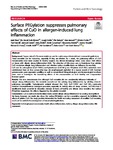Surface PEGylation suppresses pulmonary effects of CuO in allergen-induced lung inflammation
| dc.contributor.author | Ilves, M | |
| dc.contributor.author | Kinaret, PAS | |
| dc.contributor.author | Ndika, J | |
| dc.contributor.author | Karisola, P | |
| dc.contributor.author | Marwah, V | |
| dc.contributor.author | Fortino, V | |
| dc.contributor.author | Fedutik, Y | |
| dc.contributor.author | Correia, M | |
| dc.contributor.author | Ehrlich, N | |
| dc.contributor.author | Loeschner, K | |
| dc.contributor.author | Besinis, A | |
| dc.contributor.author | Vassallo, J | |
| dc.contributor.author | Handy, RD | |
| dc.contributor.author | Wolff, H | |
| dc.contributor.author | Savolainen, K | |
| dc.contributor.author | Greco, D | |
| dc.contributor.author | Alenius, H | |
| dc.date.accessioned | 2019-09-02T08:52:42Z | |
| dc.date.issued | 2019-07-05 | |
| dc.identifier.issn | 1743-8977 | |
| dc.identifier.issn | 1743-8977 | |
| dc.identifier.other | 28 | |
| dc.identifier.uri | http://hdl.handle.net/10026.1/14846 | |
| dc.description.abstract |
BACKGROUND: Copper oxide (CuO) nanomaterials are used in a wide range of industrial and commercial applications. These materials can be hazardous, especially if they are inhaled. As a result, the pulmonary effects of CuO nanomaterials have been studied in healthy subjects but limited knowledge exists today about their effects on lungs with allergic airway inflammation (AAI). The objective of this study was to investigate how pristine CuO modulates allergic lung inflammation and whether surface modifications can influence its reactivity. CuO and its carboxylated (CuO COOH), methylaminated (CuO NH3) and PEGylated (CuO PEG) derivatives were administered here on four consecutive days via oropharyngeal aspiration in a mouse model of AAI. Standard genome-wide gene expression profiling as well as conventional histopathological and immunological methods were used to investigate the modulatory effects of the nanomaterials on both healthy and compromised immune system. RESULTS: Our data demonstrates that although CuO materials did not considerably influence hallmarks of allergic airway inflammation, the materials exacerbated the existing lung inflammation by eliciting dramatic pulmonary neutrophilia. Transcriptomic analysis showed that CuO, CuO COOH and CuO NH3 commonly enriched neutrophil-related biological processes, especially in healthy mice. In sharp contrast, CuO PEG had a significantly lower potential in triggering changes in lungs of healthy and allergic mice revealing that surface PEGylation suppresses the effects triggered by the pristine material. CONCLUSIONS: CuO as well as its functionalized forms worsen allergic airway inflammation by causing neutrophilia in the lungs, however, our results also show that surface PEGylation can be a promising approach for inhibiting the effects of pristine CuO. Our study provides information for health and safety assessment of modified CuO materials, and it can be useful in the development of nanomedical applications. | |
| dc.format.extent | 28- | |
| dc.format.medium | Electronic | |
| dc.language | en | |
| dc.language.iso | en | |
| dc.publisher | BMC | |
| dc.rights | Attribution-NonCommercial-NoDerivatives 4.0 International | |
| dc.rights | Attribution-NonCommercial-NoDerivatives 4.0 International | |
| dc.rights | Attribution-NonCommercial-NoDerivatives 4.0 International | |
| dc.rights | Attribution-NonCommercial-NoDerivatives 4.0 International | |
| dc.rights | Attribution-NonCommercial-NoDerivatives 4.0 International | |
| dc.rights | Attribution-NonCommercial-NoDerivatives 4.0 International | |
| dc.rights.uri | http://creativecommons.org/licenses/by-nc-nd/4.0/ | |
| dc.rights.uri | http://creativecommons.org/licenses/by-nc-nd/4.0/ | |
| dc.rights.uri | http://creativecommons.org/licenses/by-nc-nd/4.0/ | |
| dc.rights.uri | http://creativecommons.org/licenses/by-nc-nd/4.0/ | |
| dc.rights.uri | http://creativecommons.org/licenses/by-nc-nd/4.0/ | |
| dc.rights.uri | http://creativecommons.org/licenses/by-nc-nd/4.0/ | |
| dc.subject | CuO | |
| dc.subject | Engineered nanomaterial | |
| dc.subject | Health effects | |
| dc.subject | Inflammation | |
| dc.subject | Asthma | |
| dc.subject | Allergic airway inflammation | |
| dc.subject | Risk assessment | |
| dc.title | Surface PEGylation suppresses pulmonary effects of CuO in allergen-induced lung inflammation | |
| dc.type | journal-article | |
| dc.type | Article | |
| plymouth.author-url | https://www.ncbi.nlm.nih.gov/pubmed/31277695 | |
| plymouth.issue | 1 | |
| plymouth.volume | 16 | |
| plymouth.publication-status | Published | |
| plymouth.journal | Particle and Fibre Toxicology | |
| dc.identifier.doi | 10.1186/s12989-019-0309-1 | |
| plymouth.organisational-group | /Plymouth | |
| plymouth.organisational-group | /Plymouth/Faculty of Science and Engineering | |
| plymouth.organisational-group | /Plymouth/Faculty of Science and Engineering/School of Biological and Marine Sciences | |
| plymouth.organisational-group | /Plymouth/Faculty of Science and Engineering/School of Engineering, Computing and Mathematics | |
| plymouth.organisational-group | /Plymouth/REF 2021 Researchers by UoA | |
| plymouth.organisational-group | /Plymouth/REF 2021 Researchers by UoA/UoA06 Agriculture, Veterinary and Food Science | |
| plymouth.organisational-group | /Plymouth/REF 2021 Researchers by UoA/UoA12 Engineering | |
| plymouth.organisational-group | /Plymouth/Research Groups | |
| plymouth.organisational-group | /Plymouth/Research Groups/Marine Institute | |
| plymouth.organisational-group | /Plymouth/Users by role | |
| plymouth.organisational-group | /Plymouth/Users by role/Academics | |
| dc.publisher.place | England | |
| dcterms.dateAccepted | 2019-06-04 | |
| dc.rights.embargodate | 2019-9-11 | |
| dc.identifier.eissn | 1743-8977 | |
| dc.rights.embargoperiod | Not known | |
| rioxxterms.version | Version of Record | |
| rioxxterms.versionofrecord | 10.1186/s12989-019-0309-1 | |
| rioxxterms.licenseref.uri | http://creativecommons.org/licenses/by-nc-nd/4.0/ | |
| rioxxterms.licenseref.startdate | 2019-07-05 | |
| rioxxterms.type | Journal Article/Review | |
| plymouth.funder | NANOSOLUTIONS Biological Foundation for the Safety Classification of Engineered Nanomaterials (ENM): Systems Biology Approaches to Understand::European Commission FP7 |



